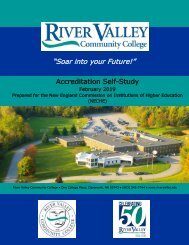Create successful ePaper yourself
Turn your PDF publications into a flip-book with our unique Google optimized e-Paper software.
The Department Chair, with help from one Academic Advisor who has a background in<br />
math, and one adjunct math faculty spent AY16-17 developing and planning the corequisite<br />
math model. This was the second major redesign of the mathematics pathway;<br />
the first occurring in 2012 which decreased the number of courses a student testing into<br />
the developmental pathway had to take from two to one. The first redesign resulted in<br />
improvements in math persistence as described in Standard Five; but did not eliminate the<br />
need for developmental courses. The Co-requisite project was planned to do just that,<br />
eliminate the developmental courses for math whenever possible for students. The project<br />
began by working with the CCSNH System-wide data analytics person to evaluate college<br />
data with specific focus on developmental math success rates and persistence rates dating<br />
back to 2011. The team then developed pacing guides and advising models for math<br />
pathways, set SAT cut scores for each math course, developed a schedule and structure of<br />
co-requisite mathematics courses, and developed training plans for instructors. Training<br />
for Program Directors was also included as this was a significant change in the way<br />
students were advised and filtered into math courses. Communication of this change to<br />
the College as a whole took place via All-College Staff Meeting, Department Chairs<br />
Meetings, and various working groups. The project plan was completed and the first corequisite<br />
courses were taught in Fall of 2017. Currently, the only developmental courses<br />
taught are for those students who show significant deficits in college-readiness related to<br />
their math skills or those students who self-select into the developmental courses for<br />
personal reasons. There are two courses: one for students entering into STEM fields, and<br />
one for students entering into non-STEM fields.<br />
Appraisal of Planning<br />
Since Fall of 2018 there has been an increase in stability of processes due to the new<br />
administrative structure under President Williams. For example, he recognized the need to<br />
finalize the College’s strategic plan. Most of the work had been done on it, but it had<br />
never been presented to the College to vote on. This was accomplished in December<br />
2018. Further improvements under the new administration include ensuring that relevant<br />
parties are at the table with regard to planning of programs, proactive rather than reactive<br />
approaches to issues, and open communication with the college community.<br />
Great strides have been made in the financial planning of the institution with improved<br />
identification of risks, improvements in involving individual departments in planning their<br />
own budgets, and increased transparency with regards to expenses and revenue. Program<br />
Directors now receive weekly updated budget spreadsheets for their programs which<br />
provides up to date information regarding spending and budgeting. This allows Program<br />
Directors increased control of supply purchasing to meet the academic needs of their<br />
students. Financial transparency has also led to improved understanding by the college<br />
community with regards to the Academic Centers and how each center contributes to the<br />
overall budget for the College.<br />
Planning and implementation of projects has also been quite successful at the<br />
programmatic level as evidenced by the implementation of the math co-requisite project.<br />
The thoughtful and purposeful plan developed prior to implementation, the implementation<br />
18 | P a g e





